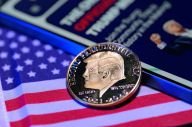Featured articles

Why Michael Burry just sold all his stocks
Michael Burry just sold over $70 million in stock, liquidating his entire portfolio except for one stock, doubling down on a company that other investors are fleeing in droves.
15:28, 18 July 2025

Euro forecast: Third-party price target
Read our EUR/USD forex rate forecast for 2025 and beyond, with insights from third-party analysts and market experts
12:06, 4 July 2025

Crypto CFDs: Popular cryptocurrencies for trading
Discover which cryptocurrencies are trending for CFD trading in 2025 – from bitcoin to newly listed coins like SUI and PEPE.
10:46, 31 July 2025

Alphabet stock forecast 2025-2030: Third-party predictions
Alphabet (GOOG) was trading at $166.80 at 15:51 UTC, within the day’s $164.66-$171.40 range. The price is holding mid-range in the session (8 September 2025).
9 hours ago

Oracle stock forecast 2025-2030: Third-party price target and future outlook
Oracle (ORCL) is trading at $238.60 on 8 September 2025 at 11:59 UTC, just below its intraday high of $239.04 and above the day’s low of $222.91.
11 hours ago

Trading the Nasdaq 100 Over 24,000
Another milestone for the tech-heavy index helps keep the technical overview bullish, but in sentiment it’s a story of opposing bias when it comes to CoT speculators and Capital.com’s clients.
15 hours ago

The US treasury market is doing something extremely unusual
After the most prolonged inversion in modern history, the yield curve is now steepened to over half a percent.
18:28, 13 September 2025

Trading the Nasdaq 100 Over 24,000
Another milestone for the tech-heavy index helps keep the technical overview bullish, but in sentiment it’s a story of opposing bias when it comes to CoT speculators and Capital.com’s clients.
15 hours ago

Trading the Dow 30 After a Weak NFP
The technical overview remains unchanged in both daily and weekly time frames, while in sentiment CoT speculators raised their net sell bias.
10:34, 8 September 2025

US 500 index forecast: Third-party US 500 price target
Discover the US 500 (US 500) index price forecast for 2025 and beyond, with analyst price targets and more.
12:59, 5 September 2025

US Wall Street 30 index forecast: Is US30 a Good Investment?
Discover the US Wall Street 30 (Dow Jones Industrial Average) index price forecast for 2025 and beyond, with analyst price targets and more
13:08, 3 September 2025

An extremely rare signal just triggered on copper
A line can be drawn on copper's price chart starting in 2006, capturing one, two, three, four reactions over 19 consecutive years.
18:57, 13 September 2025

Five factors driving gold to record highs
Major tailwinds are pushing gold to new all-time highs.
13:49, 4 September 2025

Trading gold prior to Non-Farm Payrolls
The technical overview remains volatile given the uptick in intraday price action combined with record highs, while in sentiment still a story of majority long bias among both clients and institutional traders.
07:21, 4 September 2025

Trading silver at 2011 highs
It has made quick work of the infamous $40 level to comfortably move within the handle, and it’s still a story of majority long sentiment among traders both large and small
10:04, 1 September 2025

Trading EUR/USD Amidst ECB and US CPI Events
It has been a story of relative calm and slight positive technical bias ahead of the fundamental events, with CoT speculators net long while Capital.com clients shift to the middle.
07:08, 11 September 2025

UK interest rate forecast for the next five years
Explore the UK interest rate forecast with third‑party predictions, trends, and a five‑year outlook for projected UK interest rates.
10:51, 8 September 2025

Australian dollar forecast: Third-party price target
What’s next for AUD/USD? Here’s our round-up of third-party Australian dollar forecasts, with analysts’ insights, price history, and forex rate drivers for CFD traders.
19:56, 18 August 2025

US dollar forecast: Third-party data round-up
US monetary policy and global headwinds continue to sway major forex pairs – leaving many asking: what’s next for the US dollar forecast? Dive into our roundup of third-party insights and expert price predictions for 2025 and beyond.
15:44, 18 August 2025

Trump coin price prediction 2025-2050: Third-party TRUMP insights
Read our Official Trump coin price prediction for 2025 and beyond, with TRUMP insights from third-party analysts and market experts.
08:31, 8 September 2025

Shiba Inu price prediction 2025-2050: Third-party SHIB insights
Read our Shiba Inu price prediction for 2025 and beyond, with SHIB insights from third-party analysts and market experts.
12:18, 5 September 2025

Bitcoin price prediction: Third-party price target
Read our Bitcoin price prediction for 2025 and beyond, with BTC insights from third-party analysts and market experts
17:19, 4 September 2025

Bonk coin price prediction 2025-2050: Third-party BONK insights
Read our Bonk coin price prediction for 2025 and beyond, with BONK insights from third-party analysts and market experts
10:20, 4 September 2025
